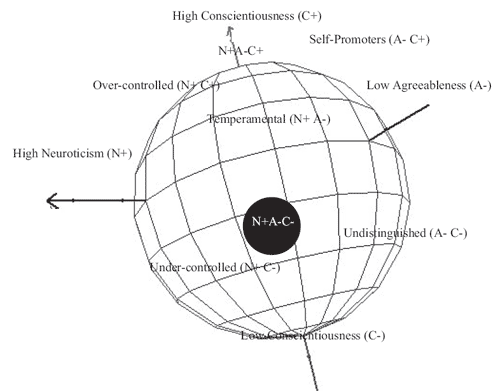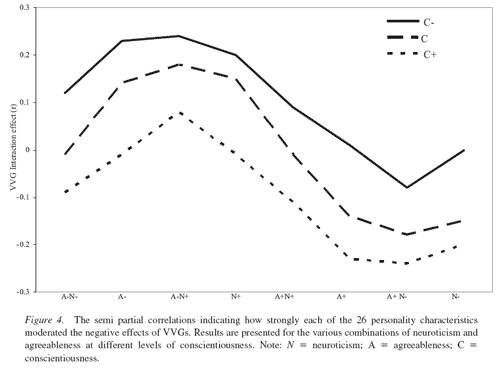Does Personality Predict Vulnerability to Violence in Games? (VG Series Part 2/10)
Neo-Academic coverage of the Journal of General Psychology special issue on the psychology of video games:
- Is Video Game Research Influenced by the Media?
- Does Personality Predict Vulnerability to Violence in Games?
- Can Spatial Cognition Be Trained with Video Games?
- How Do We Design Effective Video Games for Learning?
- Can Video Games Be Used in Health Care?
- Should Children with Autism Play Video Games?
- Should Video Games Be Used in Therapy?
- Can Video Games Get People to Vote?
- How Do Video Games Motivate People?
- How Do Typical Gamers Play Games?
![]() There are few topics so hotly debated on the Internet as the value of video games. Are they the next generation’s artistic advance, as film was for the last, or are they a blight that makes children overly aggressive and dangerous? In this 10-part series, I’m reviewing a recent special issue of the Journal of General Psychology on video games. For more background information, see the first post in the series.
There are few topics so hotly debated on the Internet as the value of video games. Are they the next generation’s artistic advance, as film was for the last, or are they a blight that makes children overly aggressive and dangerous? In this 10-part series, I’m reviewing a recent special issue of the Journal of General Psychology on video games. For more background information, see the first post in the series.
One of the trickiest parts of predicting the impact of video games on behavior is that personality as we typically conceptualize it may not be a good model. For example, if we conceptualize emotional stability as a continuum, perhaps it is the case that only those especially low in emotional stability will be affected negatively by playing violent video games. Or in other words, perhaps video game violence will only lead the emotionally unstable to become violent.
The problem with this hypothesis is that most traditional analytic techniques applied to psychological data (linear regression, ANOVA, etc.) would not work well to test this hypothesis. ANOVA, for example, would require an arbitrary split somewhere (to define “high” and “low”) while regression would require curvilinear models and/or computation of many, many interaction terms.
To avoid these problems, Markey and Markey (2010)1 introduce a new analytic perspective that I’ve never heard of – a spherical model of personality. Each combination of three Big Five personality traits can be conceptualized as a an axis of the sphere. In the example below, those high in psychoticism (which they define as high neuroticism, low agreeableness, and low conscientiousness) are expected to be at greatest risk of their behavior being affected by violence in video games.
 The advantage of a spherical model is that the data can be analyzed with the mathematical properties of a sphere – in a sense, any particular direction from the center of the sphere can be conceptualized as a main effect, which increases statistical power. Markey and Markey reanalyze data from another study by the first author to do just this – a model with 26 main effects is examined (+N, -N, +A, -A, +C, -C and all possible crosses). The result of those analyses is below:
The advantage of a spherical model is that the data can be analyzed with the mathematical properties of a sphere – in a sense, any particular direction from the center of the sphere can be conceptualized as a main effect, which increases statistical power. Markey and Markey reanalyze data from another study by the first author to do just this – a model with 26 main effects is examined (+N, -N, +A, -A, +C, -C and all possible crosses). The result of those analyses is below:
 What you’re seeing are differential effects based on direction, offering some support for the added value of the spherical model. For example, for those low in Conscientiousness (the top line), low neuroticism is associated with an effect of 0, while high neuroticism is associated with an effect of roughly .2. But I do have some concerns that make interpretation of those values a little tricky.
What you’re seeing are differential effects based on direction, offering some support for the added value of the spherical model. For example, for those low in Conscientiousness (the top line), low neuroticism is associated with an effect of 0, while high neuroticism is associated with an effect of roughly .2. But I do have some concerns that make interpretation of those values a little tricky.
There are some misunderstanding of statistical significance testing here. For example, consider this quote:
When the FFM dimensions of neuroticism, agreeableness, and conscientiousness were used to predict hostility, all of the interaction effects were null. However, when these dimensions are combined to measure a single characteristic representing high neuroticism, low agreeableness, and low conscientiousness, significant results emerged from the exact same data set. [emphasis in original]
This should not have been surprising. By redefining interaction terms as main effects, the sampling distributions of those terms changes – it is by definition “easier” to find significance. That does not, however, mean that the sampling distribution of those effects is accurate. They may just be “lowering the bar” without support to do so. This might be akin to adding a few “degrees of freedom” in your analyses for no particular reason.
The authors try to justify this approach by stating the following:
Is is important to note that the methodology of combining together three dimensions is both computationally and conceptually different than examining the interaction between the three traits. Such an interaction term would be computed by multiplying the three traits together whereas in the current analyses the combination of the traits was computed by averaging together the FFM traits with various weights.
I’m not sure I buy it. I’m not a quantitative psychologist, but I believe you would be able to get the same result by creating custom summed interaction terms and using hierarchical linear regression. Why go through the song and dance of creating a “spherical model” when you could recreate the same basic analyses with a more generally accepted analytic technique? Why use an entirely hypothetical model when you could add a new twist to a standard method (which would be much easier to test and to justify)? Despite this being a principally methodological piece, very little mathematical detail is provided on why you might take this approach versus another other than because you’ll get significant results this way, which is not a very good scientific rationale. No direct attempt is made to contrast this approach with any other, which seems quite odd to me.
Interaction terms are notoriously difficult to detect in multiple regression because you need a lot of data to accurately model the interaction. Just think about it rationally – you need values spread around all levels and all combinations of two continuous predictors. If you don’t have a lot of data, you either won’t have data at each point of interaction, or you won’t have replication of important portions of your analyses. Making it easier to find statistical significance is not by itself a legitimate reason to use a new statistical technique, unless the sampling distribution has been demonstrated empirically or at least through simulation.
So what’s the final recommendation – do the Big Five predict vulnerability to violence in video games? I wish I could give you a definitive answer. I am confident that personality is important in investigating this question. I am also confident that if personality plays a role, the effects are rather small (although this is true when examining personality in any domain). But I am not confident that this paper helps us explain any of this.
- Markey, P., & Markey, C. (2010). Vulnerability to violent video games: A review and integration of personality research. Review of General Psychology, 14 (2), 82-91 DOI: 10.1037/a0019000 [↩]
| Previous Post: | Is Video Game Research Influenced by the Media? (Part 1/10) |
| Next Post: | Can Spatial Cognition Be Trained with Video Games? (VG Series Part 3/10) |



Trackbacks and Pingbacks